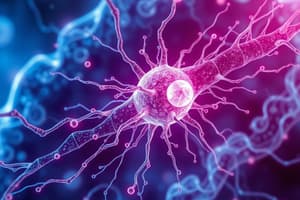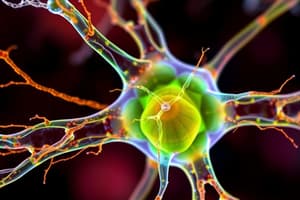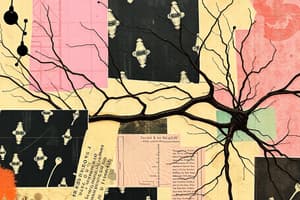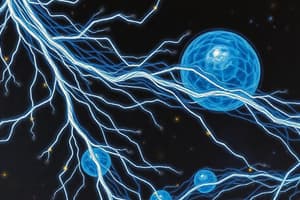Podcast
Questions and Answers
Which of the following best describes the primary function of the cytoskeleton?
Which of the following best describes the primary function of the cytoskeleton?
- To solely regulate DNA replication within the nucleus.
- To offer dynamic support, facilitate movement, and maintain cell shape. (correct)
- To act as an inert barrier against external forces.
- To provide a rigid, unchangeable structure for the cell.
How do intermediate filaments contribute to the overall function of the cell?
How do intermediate filaments contribute to the overall function of the cell?
- By solely supporting the microvilli of epithelial cells.
- By providing mechanical strength and distributing stress in tissues. (correct)
- By forming the mitotic spindle during cell division.
- By facilitating rapid intracellular transport of organelles.
What is the main structural difference between microtubules and actin filaments?
What is the main structural difference between microtubules and actin filaments?
- Microtubules are hollow cylinders, while actin filaments are helical polymers. (correct)
- Microtubules are flexible, while actin filaments are rigid.
- Microtubules are only found in eukaryotes, while actin filaments are only found in prokaryotes.
- Microtubules are composed of actin, while actin filaments are made of tubulin.
Which of the following is a primary function of microtubules within a cell?
Which of the following is a primary function of microtubules within a cell?
What determines the function and behavior of microtubules within a cell?
What determines the function and behavior of microtubules within a cell?
Which of the following statements accurately describes the structural properties of intermediate filaments?
Which of the following statements accurately describes the structural properties of intermediate filaments?
Which of the following best describes the role of the centrosome in microtubule organization?
Which of the following best describes the role of the centrosome in microtubule organization?
Which of the following accurately describes dynamic instability in microtubules?
Which of the following accurately describes dynamic instability in microtubules?
How does GTP hydrolysis contribute to the dynamic instability of microtubules?
How does GTP hydrolysis contribute to the dynamic instability of microtubules?
How do drugs like Taxol affect microtubule dynamics and cell function?
How do drugs like Taxol affect microtubule dynamics and cell function?
Which of the following best describes the polarity of microtubules and its functional significance?
Which of the following best describes the polarity of microtubules and its functional significance?
What role do motor proteins play in intracellular transport along microtubules?
What role do motor proteins play in intracellular transport along microtubules?
How do kinesins and dyneins differ in their directionality of movement along microtubules?
How do kinesins and dyneins differ in their directionality of movement along microtubules?
How do motor proteins like kinesin convert chemical energy into mechanical work?
How do motor proteins like kinesin convert chemical energy into mechanical work?
What is the role of adaptor proteins in motor protein function?
What is the role of adaptor proteins in motor protein function?
How do kinesins contribute to the positioning of the endoplasmic reticulum (ER) within a cell?
How do kinesins contribute to the positioning of the endoplasmic reticulum (ER) within a cell?
What is the function of cytoplasmic dyneins in positioning the Golgi apparatus?
What is the function of cytoplasmic dyneins in positioning the Golgi apparatus?
Which of the following describes the arrangement of microtubules in cilia and flagella?
Which of the following describes the arrangement of microtubules in cilia and flagella?
How does dynein contribute to the movement of cilia and flagella?
How does dynein contribute to the movement of cilia and flagella?
What is the underlying cause of Kartagener's syndrome?
What is the underlying cause of Kartagener's syndrome?
How does the architecture of the axon rely on microtubules?
How does the architecture of the axon rely on microtubules?
Why is dynamic instability essential for microtubule function?
Why is dynamic instability essential for microtubule function?
What role does gamma-tubulin play in the function of microtubules?
What role does gamma-tubulin play in the function of microtubules?
How does the cell regulate microtubule stability to polarize?
How does the cell regulate microtubule stability to polarize?
If a researcher discovers a new drug that inhibits GTP hydrolysis by tubulin dimers, what effect would they expect to see on microtubule dynamics?
If a researcher discovers a new drug that inhibits GTP hydrolysis by tubulin dimers, what effect would they expect to see on microtubule dynamics?
How does the cell ensure that peroxisomes are transported to the areas needed?
How does the cell ensure that peroxisomes are transported to the areas needed?
What structural component links cytoplasmic dynein to its cargo on a vesicle?
What structural component links cytoplasmic dynein to its cargo on a vesicle?
A cell is treated with a drug that prevents the formation of the nuclear lamina. Which type of cytoskeletal filament is most likely being targeted?
A cell is treated with a drug that prevents the formation of the nuclear lamina. Which type of cytoskeletal filament is most likely being targeted?
Why are cells treated with colchicine unable to progress properly through mitosis?
Why are cells treated with colchicine unable to progress properly through mitosis?
How are motor proteins related to steps in a chemical cylce?
How are motor proteins related to steps in a chemical cylce?
Which of the following is a function of cytoplasmic dynein?
Which of the following is a function of cytoplasmic dynein?
What are the implications of Kataneger's syndrome?
What are the implications of Kataneger's syndrome?
Which of the following is a role of ciliary dynein?
Which of the following is a role of ciliary dynein?
Based on their structure, what structural component would kinesins support in travel?
Based on their structure, what structural component would kinesins support in travel?
Flashcards
Cytoskeleton
Cytoskeleton
Network of protein filaments extending throughout the cytoplasm. Provides shape, support, and facilitates movement.
Intermediate Filaments
Intermediate Filaments
Rope-like fibers that provide mechanical strength and distribute stress in cells.
Microtubules
Microtubules
Hollow cylinders made of tubulin protein, more rigid than actin or intermediate filaments, often attached to centrosomes.
Actin Filaments
Actin Filaments
Signup and view all the flashcards
Cytoskeleton as Dynamic Scaffold
Cytoskeleton as Dynamic Scaffold
Signup and view all the flashcards
Cytoskeleton as Internal Framework
Cytoskeleton as Internal Framework
Signup and view all the flashcards
Cytoskeleton as Network
Cytoskeleton as Network
Signup and view all the flashcards
Cytoskeleton Function: Cell Movement
Cytoskeleton Function: Cell Movement
Signup and view all the flashcards
Cytoskeleton in Cell Division
Cytoskeleton in Cell Division
Signup and view all the flashcards
Microtubule function in epithelial cells and neurons
Microtubule function in epithelial cells and neurons
Signup and view all the flashcards
Microtubule function in Dividing Cells
Microtubule function in Dividing Cells
Signup and view all the flashcards
Intermediate Filaments Function
Intermediate Filaments Function
Signup and view all the flashcards
Microfilament Function
Microfilament Function
Signup and view all the flashcards
Microtubule Role
Microtubule Role
Signup and view all the flashcards
Centrosome
Centrosome
Signup and view all the flashcards
Microtubules in mitosis
Microtubules in mitosis
Signup and view all the flashcards
Microtubule Instability
Microtubule Instability
Signup and view all the flashcards
Cell Polarization by Microtubules
Cell Polarization by Microtubules
Signup and view all the flashcards
GTP Hydrolysis
GTP Hydrolysis
Signup and view all the flashcards
Taxol
Taxol
Signup and view all the flashcards
Colchicine/Colcemid
Colchicine/Colcemid
Signup and view all the flashcards
Microtubule Function in Axons
Microtubule Function in Axons
Signup and view all the flashcards
Microtubules Guide Transport
Microtubules Guide Transport
Signup and view all the flashcards
Motor Proteins
Motor Proteins
Signup and view all the flashcards
Kinesins
Kinesins
Signup and view all the flashcards
Dyneins
Dyneins
Signup and view all the flashcards
Motor Protein Movement
Motor Protein Movement
Signup and view all the flashcards
Kinesin and Dynein Interaction
Kinesin and Dynein Interaction
Signup and view all the flashcards
Motor Proteins Energy Conversion
Motor Proteins Energy Conversion
Signup and view all the flashcards
Kinesin and Dynein: Transport function
Kinesin and Dynein: Transport function
Signup and view all the flashcards
Kinesin Molecule Structure
Kinesin Molecule Structure
Signup and view all the flashcards
Function of minus end-directed micromotor
Function of minus end-directed micromotor
Signup and view all the flashcards
Cilia and Flagella Composition
Cilia and Flagella Composition
Signup and view all the flashcards
Kartagener's Syndrome
Kartagener's Syndrome
Signup and view all the flashcards
3 Superfamilies of motor proteins
3 Superfamilies of motor proteins
Signup and view all the flashcards
Study Notes
Cytoskeleton and Cell Motility
- The cytoskeleton's functions, microtubules, microtubule-associated proteins, motor proteins (kinesins and dyneins), and microtubule dynamics are important components
Cytoskeleton
- A network of protein filaments extends throughout the cytoplasm
- Provides cell shape, support, and facilitates movement
- Marked animal cells in culture show major cytoskeletal systems
- Microtubules appear green, actin filaments are red
- Overlapping filaments appear yellow, DNA in the nucleus appears blue
Framework
- The cytoskeleton is made of three protein filaments
- Filaments forming the cytoskeleton differ in composition, mechanical properties, and roles
Cytoskeleton Functions
- Dynamic scaffold provides structural support
- Scaffold determines cell shape and resists deforming forces
- Internal framework positions organelles within the cell
- Network of tracks directs movement of materials and organelles
- Examples include mRNA delivery
- Force-generating apparatus enables cell movement
- Essential component of cell division machinery, separating chromosomes and splitting cells during mitosis and cytokinesis
Cell Structure functions
- Epithelial and neuron microtubules mainly support organelle transport
- Dividing cell microtubules form the mitotic spindle for chromosome segregation
- Intermediate filaments support epithelial cells and neurons
- Microfilaments support epithelial cell microvilli
- Microfilaments are integral to neuronal elongation and cell division
Microtubules
- Long, stiff, hollow protein tubes
- Microtubules organize eukaryotic cells
- They rapidly disassemble and reassemble
- Originate from the centrosome
- Create a cellular track system, which enables the transportation of vesicles, organelles, and other components
Microtubules and Organelles
- Most fluorescent green organelles (peroxisomes) are closely associated with red microtubules
- Microtubules serve as tracks for peroxisome transport
- Mammalian cells display green peroxisomes, aided by a peroxisomal protein fused with a fluorescent protein
- Microtubules are stained with a fluorescently labeled antibody
- Microtubules appear red
Hollow Tubes
- Microtubules are hollow tubes made of globular tubulin subunits
- Tubulin is a dimer of α-tubulin and β-tubulin protein
- Microtubules are found in the cytoskeleton, mitotic spindle, centrioles, and cilia and flagella
- They function in cell support and movement of materials between the cell body and axon terminals
Centrosome
- The centrosome is the major microtubule-organizing center
- Tubulin polymerizes from nucleation sites on the centrosome
- The centrosome, comprised of a pair of centrioles, is surrounded by a protein matrix
- The centrosome matrix includes ringshaped structures formed from γ-tubulin
- γ-tubulin ring complex serves as the starting point for microtubule growth
- The minus end of each microtubule is embedded in the centrosome
- The plus end extends into the cytoplasm
Microtubule Instability
- Each microtubule grows and shrinks independently
- The array of microtubules anchored in a centrosome is continually changing
- New microtubules grow (red arrows) and old microtubules shrink (blue arrows)
- Microtubules shrink partially, quickly start growing again, or disappear, replaced by those from from the γ-tubulin ring complex
Dynamic Instability
- Selective stabilization polarizes cells
- Newly formed microtubules persist only if both ends are protected from depolymerization
- Minus ends of microtubules are protected by organizing centers
- Plus ends are initially free but can be stabilized by binding to specific proteins
- A nonpolarized cell has microtubules growing randomly with some shrinking back
- Encounters with capping proteins in a cell region stabilize plus ends
- Stabilization orients the microtubule array and polarizes the cell
GTP Hydrolysis
- GTP hydrolysis controls the dynamic instability of microtubules
- Tubulin dimers carrying GTP bind more tightly than GDP-carrying dimers
- Rapidly growing plus ends of microtubules are capped by GTP-tubulin
- Plus ends tend to keep growing
- This occurs until GTP is hydrolyzed to GDP, then the microtubules are released causing shrinkage
Modified Dynamics by Drugs
- Colchicine binds tightly to free tubulin dimers and prevents polymerization into microtubules
- The mitotic spindle rapidly disappears and the cell stalls in mitosis
- Taxol has the opposite effect, it binds microtubules and prevents subunit loss
- New subunits can still be added, but the microtubules cannot compress
- Taxol has the same overall effect as colchicine arresting dividing cells in mitosis
- Such antimitotic drugs are used to treat human cancers
Cell Interior Organization
- Differentiated cells are polarized
- One end of the cell is structurally or functionally different from the other
- Microtubules transport organelles, vesicles, and macromolecules along a nerve cell axon
- Microtubules in the axon point with plus ends toward the axon terminal
- Oriented microtubules are tracks for directional transport of materials synthesized in the cell body
- Axonal transport from the spinal cord to a shoulder muscle takes about two days with outward and backward traffic using specific motor proteins
- The backward traffic includes worn-out mitochondria and materials ingested by the axon terminals
- Microtubule activity depends on accessory proteins
Motor Proteins
- Motor proteins move along cytoplasmic microtubules
- Two families exist: kinesins and dyneins
- Kinesins move toward the plus end
- Dyneins move toward the minus end, toward the cell body
- Kinesins and cytoplasmic dyneins are dimers with two globular ATP-binding heads and a single tail, while ciliary dyneins have a different structure
- Globular heads move along microtubules
- Kinesins move toward the plus end, dyneins to the minus end
- Each dimer has two globular heads to bind and hydrolyze ATP
- Heads interact with microtubules with a tail that interacts with cargo
Motor Proteins Drive Transport
- Kinesin and dynein globular heads are enzymes that have ATP-hydrolyzing (ATPase) activity
- Kinesin "walking" includes hand-over-hand movement along a filament
- Two heads use ATP to move
- ATP hydrolysis and phosphate release loosens the rear motor head from the microtubule
- ADP release and ATP binding, a conformational change causes a rear head flip to the front
- This completes a single step for directional movement
Cargo Transport
- Kinesin and dynein heads interact with microtubules stereospecifically
- Motor proteins attach to microtubules in one direction
- The tail binds to a cell component, such as a vesicle or organelle, which decides the cargo
- Motor proteins convert ATP chemical energy into mechanical energy for movement
- cargo moves, and muscle cells contract using movement caused by these proteins
- Cargo towards plus ends is transported by kinesin motors, each for specific vesicles, organelles, or molecules
- The kinesin tail binds directly to the cargo
- Different adaptor proteins enable the same type of kinesin to carry different cargos
- Transport toward the minus end is mediated by cytoplasmic dynein, which uses adaptor proteins
- Selected cargo is transported with cytoplasmic dynein
Kinesins
- Kinesins move along MT filaments powered by ATP hydrolysis and perform cell functions
- These functions include mitosis, meiosis, axonal transport, and moving cargo
- Kinesin-1 consists of two heavy chains that wrap into a common stalk form with two light chains at the globular ends of heavy chains
- The human genome encodes three heavy chains and four light chains for kinesin-1
- Force-generating heads bind to the microtubule and the tail binds to the cargo being transported
- Kinesin-1 transports mitochondria, endoplasmic reticulum, and Golgi-derived vesicles to carry messenger RNAs
Cytoplasmic Dynein
- Discovered in 1963 for moving cilia and flagella
- Only two cytoplasmic dyneins enable management unlike kinesins that have adapted functions
- Dynein positions the spindle and moving chromosomes during mitosis, acting as a force-generating agent
- As a microtubular motor, dynein positions the centrosome and Golgi complex
- Dynein moves organelles, vesicles, and particles through the cytoplasm
Cytoplasmic Dynein transport
- Contains two dynein heavy chains and smaller intermediate and light chains at the base
- Each dynein heavy chain contains a force-generating globular head
- A protruding stalk contains a binding site for the microtubule, and a stem for movement
- Two vesicles move bidirectionally, kinesin moves it toward the plus end
- Cytoplasmic dynein moves it toward the minus end along the same microtubule
- Each vesicle contains inactivated kinesin or dynein
- Integral and peripheral membrane protein, and a soluble protein complex called dynactin allows attachment for vesicles
Organelles Positioning
- Microtubules and motor proteins position organelles in eukaryotic cells
- Endoplasmic reticulum (ER) tubules are located near the edge of the cell, and the Golgi apparatus is located near the centrosome
- The ER expands along microtubules
- Kinesins pull the ER outward, and dyneins pull the Golgi apparatus inward
- Regional differences are vital for cell functions
Movememnt from Dynein
- Hairlike cilia project from the respiratory tract
- A cilium beats using repetitive movements of a power stroke and a recovery stroke
- Flagella use wavelike motion
Cilia and Flagella
- Microtubules in a cilium or flagellum are arranged in a “9 + 2” array with nine doublets and two central microtubules
- Unicellular alga cross sections are examined
- The nine outer microtubules (paired) carry two dynein rows
- Dynein heads arms reach toward the adjacent doublet microtubule
- Dynein heads connect and move along it, producing ciliary beating
Dynein and Bending
- Dynein slides microtubules and enables movement
- In sperm flagella, doublets slide with ATP present
- In intact flagella, there is bending rather than sliding with flexible protein links
- Ciliary dynein generates the bending motion
Dynein Defects
- Dynein defects cause Kartagener’s syndrome in humans
- Syndrome causes defects, dyskinesia, and situs inversus totalis
- Symptoms include respiratory infections, sinus infections, ear infections, and nasal congestion
- Men with a sperm disorder are infertile
- Increase susceptibility to bronchial infections because paralyzed cilia cannot clear lungs
- Mutations in many genes can cause the syndrome and lead to cells being either immotile or dysmotile
Motor Proteins superfamilies
- Motor proteins are grouped into kinesins, dyneins, and myosins
- Motor proteins convert ATP, chemical energy into mechanical energy
- Motor proteins are used to create force, contract muscle cells, and move cellular cargo
- Kinesins and dyneins move along microtubules
- Myosins move along actin filaments
- Motor proteins move unidirectionally along the cytoskeletal track
- The protein undergoes conformational changes during each mechanical cycle that provide energy
Studying That Suits You
Use AI to generate personalized quizzes and flashcards to suit your learning preferences.




